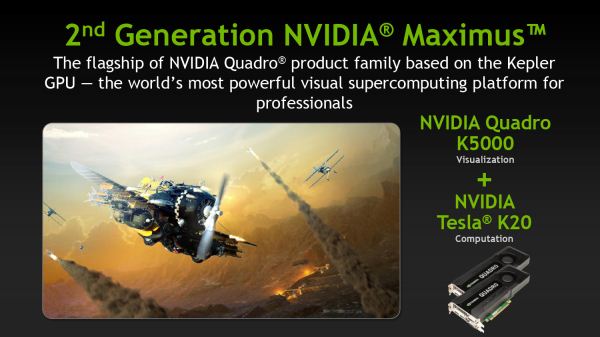NVIDIA Announces Kepler-Based Quadro K5000 & Second-Generation Maximus
by Ryan Smith on August 7, 2012 10:00 AM ESTSecond Generation Maximus
NVIDIA’s second announcement of the day directly ties into the Quadro announcement, which is the announcement of NVIDIA’s second generation Maximus technology. Strictly speaking this isn’t a new technology in and of itself – it’s the same concept of using a Quadro card and a Tesla card together in a single system and is based on the same software – but for marketing purposes NVIDIA is going to be separating Maximus based on the generation of the video cards involved.
From here on NVIDIA’s first generation Maximus technology will refer to pairing together Fermi cards, e.g. Quadro 6000 paired with a Tesla 2075. Second generation Maximus on the other hand will refer to pairing together Kepler cards, specially a Quadro K5000 with a Tesla K20.
The significance of this announcement isn’t in the branding itself, but rather what it represents for NVIDIA. Because NVIDIA is not launching a GK110 Quadro card (or at least not yet) Maximus’s importance in NVIDIA’s ecosystem has been greatly elevated virtually overnight. For the Fermi generation all of NVIDIA’s high-end Quadro cards were capable of both high performance rendering and high performance compute, with the Quadro 6000 in particular being a superset of both the Quadro and Tesla families by offering NVIDIA’s best graphics performance combined with their best compute performance. Maximus improved the experience by offloading compute onto a Tesla card – and thereby bypassing the performance penalty of frequently context switching – but Maximus wasn’t strictly necessary for high performance compute with Quadro.
Second generation Maximus on the other hand sees Maximus become essential to compute performance. Because of GK104’s limited compute performance, Quadro K5000 cannot achieve high compute performance on its own; at best it’s a great graphics product and a decent single-precision compute product. Instead Quadro K5000 needs to be paired with a GK110 Tesla card in order to achieve both high graphics performance and high compute performance. Second generation Maximus in turn is the technology and branding glue that brings all of this together.
As we mentioned in our quick look at the Quadro K5000, NVIDIA going this route isn’t particularly surprising given the fact that GK104 is such a strong performer at graphics tasks and is far more available than GK110, but it means that NVIDIA is now very reliant on Maximus in all situations that call for a Quadro video card with strong compute performance. It also means that NVIDIA is at the mercy of application developers to a certain extent as developers need to specifically accommodate Maximus. To NVIDIA’s credit the number of programs supporting Maximus has more than tripled in the last year, but that’s still a far cry from the hundreds of applications professionals typically use.
For this reason we wouldn’t be shocked to eventually see a GK110 Quadro card, but until that time this is NVIDIA’s flagship graphics + compute solution.












29 Comments
View All Comments
puppies - Wednesday, August 8, 2012 - link
"roughly" the 680 will destroy itRictorhell - Wednesday, August 8, 2012 - link
lol Um....like destroy it 5x times over, 10x, 20x? :)BiggieShady - Wednesday, August 8, 2012 - link
By the power of seaarchh ... http://www.hwcompare.com/12476/geforce-8800-gtx-vs...Ryan Smith - Wednesday, August 8, 2012 - link
The 8800GT is a hair slower than the 8800GTX, but otherwise this should give you a pretty good idea.http://www.anandtech.com/bench/Product/521?vs=555
Rictorhell - Wednesday, August 8, 2012 - link
Thank you, I appreciate the help.dtolios - Wednesday, August 8, 2012 - link
Which does not really boost the GPU accelerated envelope - call it dev's failure to optimize for Kepler, or nVidia's gaming oriented RnD...the only thing that saves them in workstation graphics are AMD's driver issues with many OpenCL accelerated applications, and ofc the stubbornness of some software devs to stick with CUDA. Another couple of years of "the same" overpriced Quadros.johnthacker - Wednesday, August 8, 2012 - link
122W TDP, less than the 142W of the single slot Quadro 4000, and they can't make a single slot card? We have some various chassis where it would be highly useful if it were single slot.ExarKun333 - Saturday, August 11, 2012 - link
You are just ridiculous. Please stop talking.Gadgety - Saturday, December 15, 2012 - link
Looks like Nvidia really want to sell their Maximus, as the FP64 is 1/24 FP32.